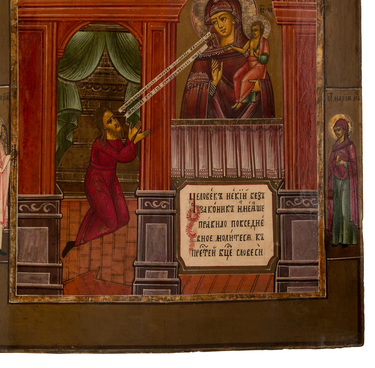It was decided by lot that Andrew was to preach Christianity in the lands around the Black Sea, including Scythia located to the north. Later, because of this fact, the legend of the apostle’s journey to Russia was included in the “Russian Primary Chronicle”.
Painted according to the rules of proportions suggested by Dionisius (the head to the total height is one to nine), the narrow, elongated figure of Andrew the First-Called stands on dark high (almost a third of the height of the central part of the icon) ground (a pozema — a conventional depiction of earth in icons), half-turned to the viewer. With both hands he holds the Gospel — a symbol of his apostolic ministry.
The apostle is dressed in a red chiton and a blue
himation; his robes sparkle with gold. The background is painted with a light
ocher close in tone to gold. The face is painted rather dark and almost
monochrome: the painter used dark shades of ocher to draw even darker outlines
of the nose, eyes, and lips. Only the whites of the eyes and the little dashes
around them are made with light touches of white; these dashes are used to
enliven the image. Two black dots indicate the pupils. A pair of thin red
stripes denote the lips. The eyes are deliberately enlarged relative to the
understated lips — this is a well-known iconographic technique that is used to
symbolize the ascetic lifestyle of the saint. The elongated body also
highlights Andrew’s asceticism. The face is elegantly, masterfully framed by
stands of gray hair made with whitewash.


